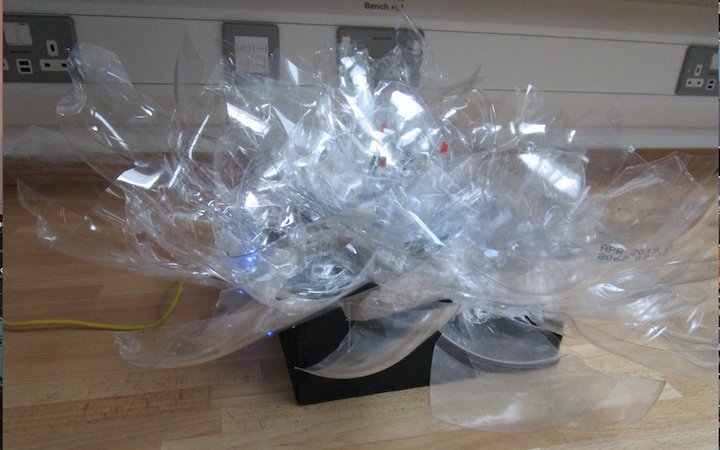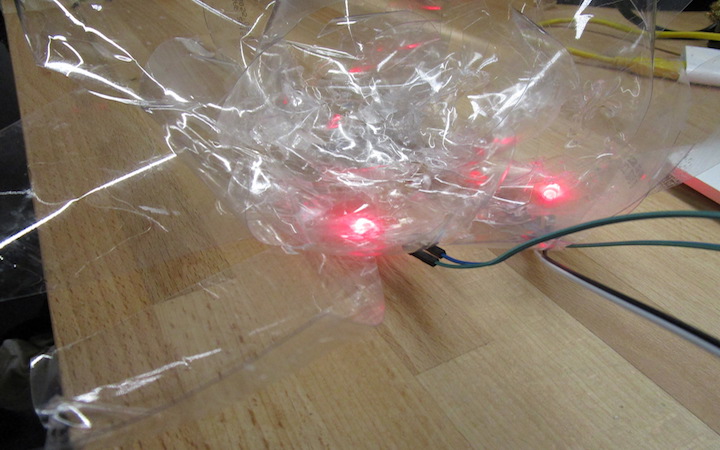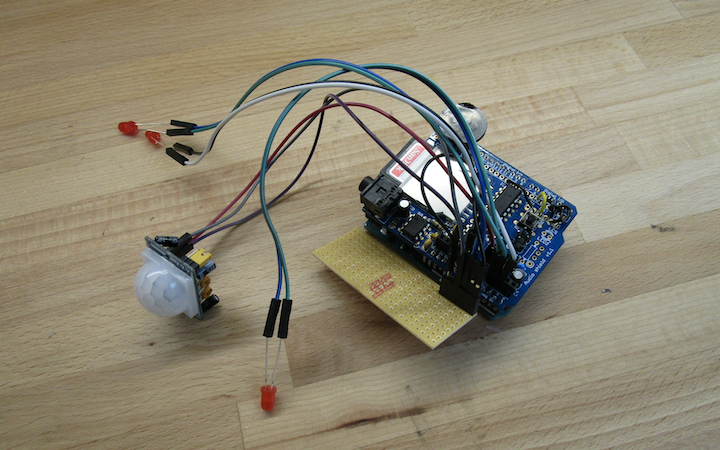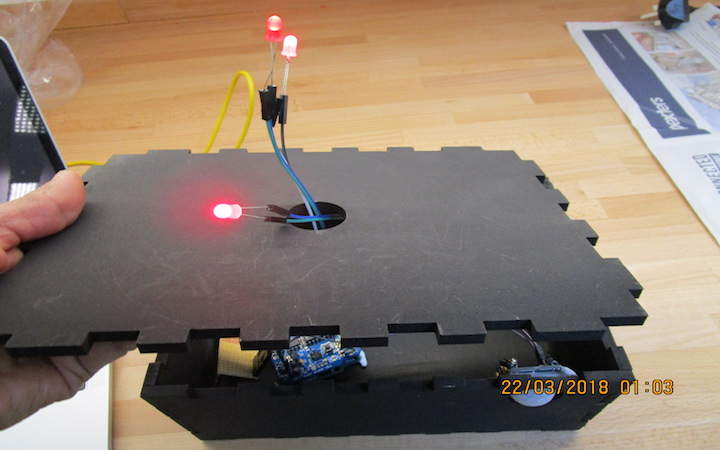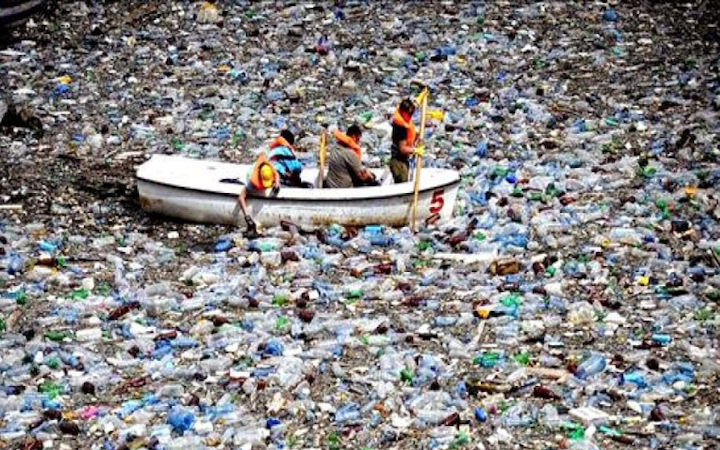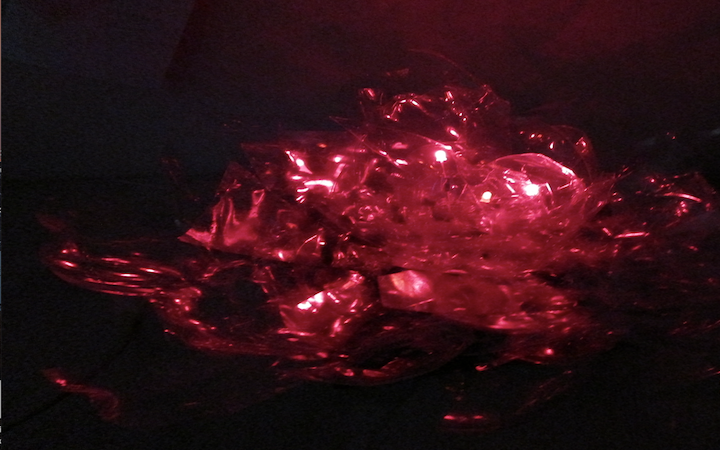Project Title WhaleSOS
WhaleSOS is an Arduino/waveshield-driven work that articulates sounds from a whale as flashing Morse code SOS signals, in the centre of a sculpture made from discarded plastic water bottles.
produced by:Gaytri Geeta Roopnarine
Concept:
This work was inspired by the concerns at the increasing amounts of plastics that we use and pollute the environment. Plastics are also a health hazard. In its stable form as a heavily crossed linked polymer, the BPA in plastics is considered benign but when the bonds are broken, the released chemicals can cause heath issues. I wanted people to think about plastics and to most importantly give a voice to these sea creatures that we glibly take advantage of by dumping plastics and other materials in the oceans. I wanted to map the cry of a sea creature to LED flashing Morse Signals for help.
I found a library with marine animals sounds and I decided to use the humpback whale call. After listening it several times ,I felt as though there was a wealth of information within the sounds that was interesting and incredibly moving at times.
I imagined the work being in a dim corner of a gallery and when a visitor approached, the PIR sensor would recognised movement and send directions to the Adafruit wave shield to begin playing the sounds and at the same time, instantiate the morse code flashing of the LED lights placed in discarded plastic bottles.
Technical:
The challenging aspect of the project involved soldering the components of the Adafruit Wave Shield. Adafruit sells a shield which consists of at least twenty-three components that have to be soldered in the correct order. Initially I was wary of burning the circuits with the soldering iron in spite of the soldering done last term. Before attempting to solder the shield, I made several attempts of soldering head pins to improved at my technique and build my confidence.
In order to get the shield to work with the led lights I decide to test each component individually and then combine them together. First I tested the led lights using a simple Arduino program for Morse code. Then I tested the PIR sensor with the LEDs which worked. It was challenging to get the wave shield to work although Adafruit provides code for formatting the SD card and then more code for playing sound. I researched on a number of forums on this subject in which people had difficulty in get the shield to work. Most of the advice centred around the proper soldering of the shield so when I started , this was an important concern for me as the shield lay at the heart of the work. I soldered the board, taking my time and checking and rechecking ghat the components were in the correct position and orientation on the board before soldering. As there were a lot of complaints about the SD card not working and I decided to get a proper validated SD card, formatted with the Fat 32 system instead of a cheaper generic SD card.
In spite of all these precautions, initially I got no sounds. It took another few days of researching on the forums and trying different advice until early one morning, I heard this beautiful sound coming from the wave shield: sounds of a whale!
The PIR sensor worked with the whale sound. After making various efforts to solder the connections of the led lights connected through a board with resistors and getting no results,( LED lights not responding to the PIR, shield and code), I got some advice and simplified everything. I connected the LED lights to the A1, A2 and A3 pins and to ground via a bridge. I connected the data pin of the PIR sensor to the AO pin on the shield /Arduino, the ground pin to ground of shield/Arduino and positive connection to the Arduino /shield which then worked.
Design considerations:
I wanted to subvert the use of the plastics form being a pollutant to something that became a protective device for the SOS signals. It was important that the plastics was seen working with the whale sounds instead of being antagonistic as it’s not the fault of the plastics but of us as a human race! At first I experimented with plastic bottles which I twisted and made into sculptures of abstract figures. After thinking about it and having a mini tutorial with Saskia, I decided to investigate coloured plastics, trying for another kind of intervention of the material. After looking at several kinds of paints such as acrylic, enamel, and oil paints, I felt that the plastic had to stand on its own. I was interested in the transparency of the plastics and how it can reflect its surroundings, him much like water, or stay hidden in its environment until activated so I began to imagine a sea creature, or sea plant at he bottom of the ocean. A memory came of a visit I made to the Buccoo Reef in Tobago years ago, when it was breathtakingly beautiful and now is like a desert with most of the animals and corals gone.
Adafruit wave shield: Audio is played asynchronously as an interrupt, so the Arduino can perform tasks while the audio is playing. It can play any uncompressed 22KHz 16bit (on a 12bit DAC), mono Wave (.wav) files of any size. Output is mono, into L and R channels, standard 3.5mm headphone jack and a connection for a speaker that is switched on when the headphones are unplugged.
Pir motion sensor: The PIR motion sensor is a sensor which can detect movement through picking up infrared radiation. Because people give off radiation because of our generated body heat, the PIR sensor can easily detect motion within the sensor’s range.
Future development: There are a lot which can be developed. First of all to actually map frequencies of the sound to the blinking of the LED lights. I could investigate alternative forms of sculpture in plastics and map sea sound to them. I would like to work with the sounds of oceans as well. Plastics and recyclable material carry a lot of information, both emotional and otherwise and can be a rich areas to articulate within the space of a socially concerned art practice.
I am also working at mapping the whale sounds as in visual and sculptural forms. This was also done in processing with photo data from the gyres of plastics in the ocean.
Materials:
Adafruit wave shield
Speaker
Pir motion sensor
Red Led diode lights
Discarded plastic drinking bottles
Sound data of the Humpback Whale (Megaptera novaeangliae)
Downloaded from the Watkins Marine Mammals Sound Base:
http://cis.whoi.edu/science/B/whalesounds/bestOf.cfm?code=AC2A
References:
https://www.news-medical.net/news/20100320/Impact-of-plastics-on-human-health-and-ecosystems.aspx
https://learn.adafruit.com/adafruit-wave-shield-audio-shield-for-arduino/overview
https://learn.adafruit.com/pir-passive-infrared-proximity-motion-sensor?view=all
http://www.learningaboutelectronics.com/Articles/Motion-sensor-light-circuit.php
https://create.arduino.cc/projecthub/onyx/morse-code-s-o-s-flasher-c0d296
http://www.instructables.com/id/Arduino-Motion-Sensor-Control-Led-Light/
































































